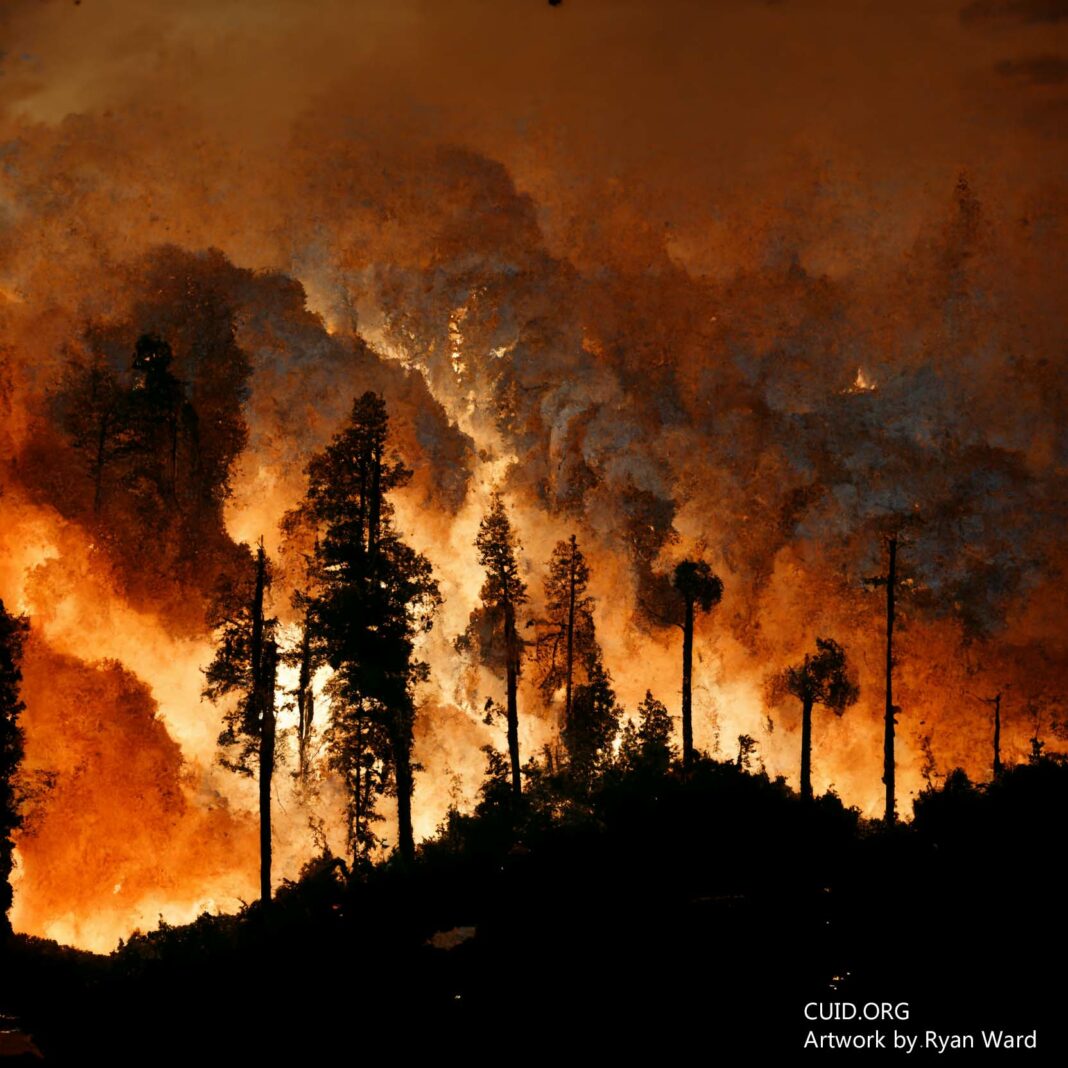Published: Timothy Arvan, and artwork by Ryan Ward.
President Donald Trump has been known to fight fire with fire, aggressively countering his detractors on issues from border security to the economy with trademark firestorms of charged and often fallacious tweeting. The Administration’s response to last fall’s catastrophic California wildfires has been no exception to this pattern. In the wake of blazes which claimed 98 civilian lives, an inflammatory Executive Order has ignited a fiery debate over the efficacy of California’s forestry strategies. Ultimately, the policy amounts to little more than political blame-shifting and dangerously misguides the public on effective fire management. Most consequentially, the federal government has eschewed both economic logic and moral duty by failing to address escalating climate change costs to the region.
The Executive Order in question is clear in its objectives to promote “active management” of federal forests and rangelands, reduce wildfire risk and protect public safety. Cloaked in the lofty language of a federal wildfire strategy, however, the Order lays out a series of illogical and ignorant policy prescriptions that align with the president’s equally head-scratching claims blaming the state’s fire problem on insufficient “raking and cleaning […] like they do in Finland” and “bad environmental laws” causing local water shortages. To be clear, Finns do not rake their forests and California has no such water scarcity.
Based on a prolific body of misinformation, the Executive Order directs Trump’s Interior and Agriculture departments to dramatically upscale brush and dead tree removal on federal lands, prescribing the extraction of 4.4 billion board feet of timber across 4.25 million acres in the coming year. While the efficacy of efforts to lower fire-causing fuel buildup has long been debated, the Trump Administration’s “strategy” to increase logging by 31 percent since 2017 has been roundly condemned by fire ecologists as ineffective. Unmoved by logic as ever, the president compounded a cause for political uproar with the suggestion that he will withhold millions of dollars in Federal Emergency Management Agency (FEMA) disaster aid to California unless local officials “get their act together.” This attempt to hold the state’s feet to the fire is, of course, an unethical intimidation tactic beneath the dignity of the Chief Executive.
As the government plays politics with critical funding, efforts to quantify the damage of California’s fires have recently yielded the startling estimate that 2018’s blazes could become the most expensive natural disaster in US history. In the face of multi-billion dollar costs, California’s major insurance providers have scrambled to rethink the risks and associated coverage for wildfire protection in vulnerable areas of the state. However, losses extend far beyond the scope of traditional insurance-based estimates accounting for destroyed property, foregone business income, and public health impacts from hazardous smoke-related particulate matter. For instance, lost employment opportunities and declining tourism are expected to create severe declines in tax revenue for local and state governments. Additionally, factors including mudslides, exacerbated by heavy rains in areas uprooted in the fires, increase the costs of restoration and further drive down regional property values as fire-wary residents debate whether to rebuild or move out. Considering the full breadth of impacts, AccuWeather places total economic losses at $400 billion, or roughly two percent of the 2018 American GDP.
Notably, economic losses from wildfires are inequitably distributed, disproportionately burdening low-income minority residents whose tighter budgets mean relatively high transition costs of relocating and finding new jobs. These populations may additionally experience a higher incidence of respiratory diseases and deterioration of pre-existing health conditions as low socioeconomic status has been identified as a principal indicator of health risk. As such, long-term wellness outcomes for the poor are unduly harmed by exposure to fire-induced particulate pollution. Indeed, municipalities across the state must grapple with broad public health repercussions from fire-induced urban air pollution episodes, while rural regions face innumerable agricultural and land management challenges, demanding innovative adaptation strategies.

The sheer magnitude of California’s damages, combined with the weight of distributional injustice, underscores the economic and social case for urgent federal policy to combat climate-related threats. However, while a chorus of fire experts have called for comprehensive measures that incorporate adaptation plans and employ controlled burns to prevent massive, destructive blazes, the Trump Administration is content to distract, deflect, and demur. Speaking to California reporters at the height of twelve active fires, former Interior Secretary Ryan Zinke falsely maintained that “this has nothing to do with climate change,” preferring to blame “environmental terrorists” for obstructing management efforts. The objective reality is that climate change is already here, imposing an ever-diversifying array of threats to human-natural systems. Indeed, wildfire risk projections predict a significant intensification of the frequency and scale of catastrophic fires in California through 2100, all while population growth and continuous development of the state’s economic centers will magnify threats to local communities. In light of this dire outlook, misconceived policies like Trump’s abdicate federal leadership, renounce science and ignore the obvious humanitarian and economic imperative of addressing climate change, all in the interest of political expediency.
Ultimately, Trump’s federal wildfire plan amounts to firing politically-tinged insults at California’s progressive institutions and should remain in the Twittersphere where it belongs. Meanwhile, in states like California, unmitigated climate change is sure to produce an outcome with which Trump is already intimately familiar: “fire and fury the likes of which the world has never seen.”
References:
[1] “All False Statements Involving Donald Trump.” Edited by Angie Drobnic Holan, PolitiFact, Nov. 2019.
[2] Executive Order. No. 13855, 2019, pp. 45-48.
[3] Reidmiller, David. “Fourth National Climate Assessment: Summary Findings.” U.S. Global Change Research
Program, 23 Nov. 2018.
[4] Boyer, Dave. “Trump Signs Executive Order to Create Federal Wildfire Strategy.” Associated Press News, 21 Dec.
2018.
[5] “California Wildfires: Finland Bemused by Trump Raking Comment.” BBC News, BBC, 19 Nov. 2018.
[6] Kelly, Caroline. “’Make America Rake Again’: Confusion in Finland over Trump’s Wildfire Comments.” CNN,
Cable News Network, 20 Nov. 2018.
[7] Friedman, Lisa. “Trump Inaccurately Claims California Is Wasting Water as Fires Burn.” The New York Times,
The New York Times, 6 Aug. 2018.
[8] Fears, Darryl, and Juliet Eilperin. “Trump’s Executive Order Will Cut More Forest Trees; CU Boulder Professor
Says ‘We Can’t Log Our Way out of the Fire Problem.’” The Denver Post, 14 Jan. 2019.
[9] Siegler, Kirk. “Will More Logging Save Western Forests From Wildfires?” NPR, 29 Aug. 2018.
[10] Hanson, Chad. “More Logging in California’s Forests Won’t Prevent Wildfires, No Matter What the Trump
Administration Says.” The Sacramento Bee, 14 Sept. 2018.
[11] Fears, Darryl. “Trump Quietly Issues Executive Order during Shutdown to Increase Logging and
Deforestation.” The Independent, Independent Digital News and Media, 15 Jan. 2019.
[12] Daniels, Jeff. “Trump Threatens to Cut off Federal Funding for California Wildfire Relief.” CNBC, 9 Jan. 2019.
[13] Myers, Joel N. “AccuWeather Predicts 2018 Wildfires Will Cost California Total Economic Losses of $400
Billion.” AccuWeather, 8 July 2019.
[14] DaSilva, Richard. “Latest Estimates of Insured Losses from California Wildfires at $9B to $13B.” Insurance
Journal, 20 Nov. 2018.
[15] Stein, Vicky. “8 Numbers That Tell the Grim Story of California’s Wildfires.” PBS, Public Broadcasting Service,
30 Nov. 2018.
[16] See footnote 13.
[17] Dowd, Jennifer Beam, and Allison E. Aiello. “Socioeconomic Differentials in Immune Response.” Epidemiology,
vol. 20, no. 6, 2009, pp. 902–908.
[18] Culver, Nina. “U.S. Forest Service Ecologist Says Mega Wildfires Require More than Suppression, Urging 3-Step Solution.” The Spokesman-Review, 17 Oct. 2018.
[19] Luery, Mike. “Environmentalists Partially to Blame for Severity of CA’s Wildfires, Interior Chief Says.” KCRA, 13 Aug. 2018.
[20] Hurteau, Matthew D., et al. “Projected Effects of Climate and Development on California Wildfire Emissions
through 2100.” Environmental Science & Technology, 2014, pp. 2298–2304.
[21] Bierman, Noah. “Trump on His Threat to North Korea: ‘Maybe It Wasn’t Tough Enough.’” Los Angeles Times, 10 Aug. 2017.



